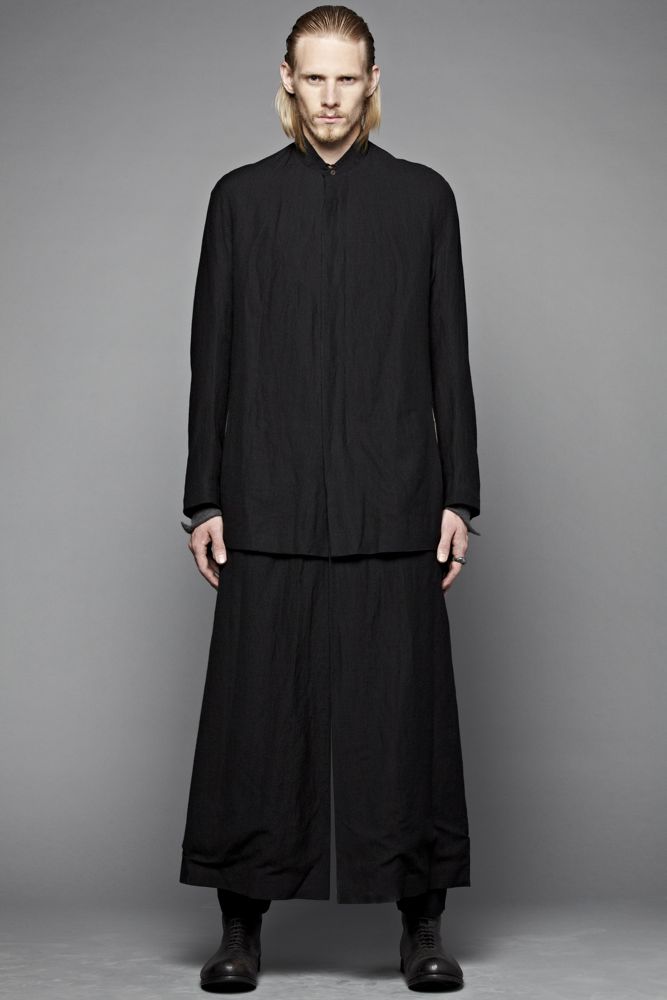Menswear Monday: Atelier New York
There’s more to menswear than suits and ties. Every other Monday, we’re giving the fastest developing facet of fashion the attention it deserves and introducing the designers, buyers, trendsetters, and stylists you need to know.
With fall collections just starting to arrive in stores, the all-black-everything sensibility at Atelier New York makes it a good place to start dressing for the cold. In the last 10 years, the shop’s owner, Karlo Steel, has moved his understated wares from a tiny storefront on Crosby Street to a big, lofty space on Hudson Square, before signing the lease last month on a brand new showroom set-up in Chelsea at 210 Eleventh Avenue.
Most people have heard of some of the designers that Steel stocks at Atelier, often in the same breath, and maybe in an A$AP Rocky verse: Ann Demeulemeester, Yohji Yamamoto, Damir Doma and company are all mainstay merchandise. But alongside them on the sales floor are a few names with smaller fanbases that are hard to find anywhere else in New York, like m.a+, BBSXANY, and InAisce. It’s a mix that’s helped Atelier build out its own cult status in the city’s menswear market, stocking everything in a steady palette of non-colors and keeping the emphasis on interesting cuts. Think pleating on full-length black wool skirts, bohemian draping on black jogging trousers, heavy ribbing on overlong black sweaters, and so on.
We connected with Steel on a break from shooting new arrivals at the store to discuss his ideas for this season, his rejection of strictly gendered dressing, and how to dress like a real New Yorker.
BUYER: Karlo Steel
ESTABLISHED: 2002
BASED IN: New York
WHY SO SERIOUS: Perhaps I’m a little blinded by certain cities, especially the city I’m living in now. New York is architecturally very Gothic—you know, Gotham. It’s very vertical, it’s very pointy, it’s dark, it’s dense, and there are certain vibrations that come up when I think of people in an urban setting. I never buy clothes with a bucolic setting in mind. I don’t think about fields of buttercups, because it’s simply not my reality. There’s a certain sensibility I have concerning dark clothes—and when I say dark, I’m talking primarily black, gray, and white—because I find there’s a certain discretion in the way that men dress in them. But that’s not to say that I don’t believe in strong and bold propositions within that darkness.
STORY OF THE SEASON: What I am seeing in menswear right now seems to be a return to “raw edge,” i.e. unfinished hems, although this time it’s combined with fine materials and clean, structured tailoring.
BOYS VS. GIRLS: What I look for is design, and there’s very little of that in menswear. Menswear is all about styling and proposing new proportions. It’s all tweaks. The blazer has been invented, so shall we use one button or two buttons or three buttons? Shall they be high, shall they be low, shall it be double-breasted? Design for men, you’ll have a very difficult time of it. It can happen and it has happened, but they should expect a lot of headwind, and those are the designers that I look for. I personally have always been quite envious of the laboratory that exists for the other gender. I’m far more enamored with women’s style than I am with men’s style, even though this is a men’s store. I draw a lot of inspiration for the way I dress and the way I buy from what women wear and how women dress. It’s a much more exciting game over there, and I try to make it applicable for men.
FUTURE COLLECTOR’S ITEM: It’s a shirt jacket by Christophe Lemaire. It’s a wool jacket, it doesn’t have a collar or a lapel, it’s just a V-neck shape with a closed placket, the buttons are hidden. There are two patch pockets at the breast, and it has shirt detailing at the bottom. That particular piece is incredibly versatile. You can wear it as a jacket with a T-shirt underneath it, you can wear it as a shirt with nothing underneath it, and it’s also one of those pieces that slides very easily under a coat, because sometimes that can be a challenge. It has no structure, yet it functions like both a shirt and a jacket. And the best part is that it’s only $500. [laughs]
FAVORITE FINDS: The two brands I’m having a wild affair with right now are Thamanyah and Ziggy Chen. Thamanyah’s designer is from the United Arab Emirates, and basically what he’s done is proposed kandoras as fashion. It’s considered traditional garb there, but he’s basically retooled it by making the sleeves higher and the arms more slender and doing interesting cuts so that they move a certain way when you wear them. I like this idea of taking something very traditional and retooling it and making something that’s applicable for now.
Ziggy Chen is from Shanghai, and he’s done a similar thing where it’s traditional Chinese clothing, but it’s from the late 1800s and early 1900s when they were just beginning to feel the influence of the West, so it’s a Chinese take on traditional Western forms of males’ dress.
GLOBAL STYLE: I think that certain countries have traditions that help them with craft and production, like Italy for example. But I think what we’re talking about here is a certain sensibility, and I think that sensibility can be honed and sharpened from any place on the globe. The internet, for all intents and purposes, gives us access to all areas, so there are people who are very clued in that are coming from very different parts of the world. It’s everybody, everywhere.
Menswear Monday runs every other Monday. For more, click here.







